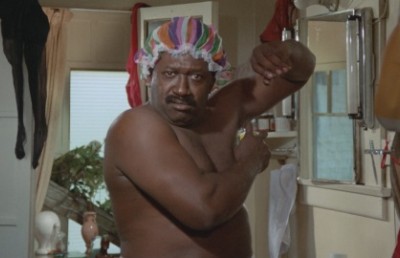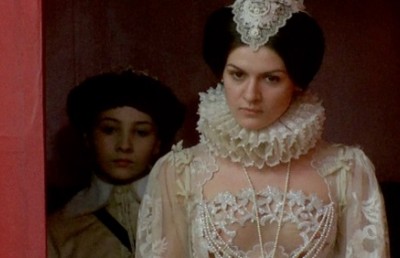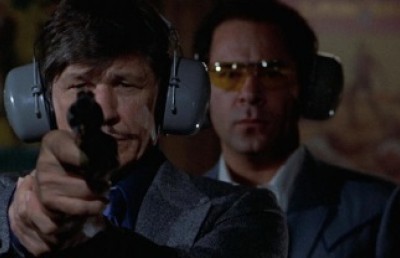Jaws (Steven Spielberg, 1975)
_1000_420_90_c1.jpg)
‘I don’t think you appreciate the gut reaction people have to these things, Martin. It’s all psychological. You yell ‘Barracuda,’ everybody says ‘Huh? What?’. You yell ‘Shark’? We’ve got a panic on our hands on the Fourth of July.’
- Mayor Vaughn (brilliant character actor Murray Hamilton) delivering one of the many pitch-perfect speeches in the film (I mean, I gotta wonder, was it Hamilton or Spielberg who decided on that sublime inflection on that last word ‘July’), working – in true conniving politician fashion — to convince the incredulous Chief of Police Brody (Roy Scheider) on the importance of ignoring all that pesky evidence of a shark in the area so they can keep those tourist money-making beaches open
A massive great white shark (otherwise known as ‘Bruce’, the dysfunctional, oft-sinking mechanical production nightmare, causing more havoc and gobbling up more precious production hours than even the worst diva sitting in their trailer refusing to come out for their close up) decides to set up its feeding grounds right off the shores of fictional Amity Island… just in time for the swarm of tourists to storm the beaches off the picaresque white picket town for the summer holiday…
As I happened to be down in New York City accompanied by my 13 year old daughter, I figured it was as good a time as any to introduce her, at hipster Williamburg’s very own Nitehawk Cinema during its now annual Fourth of July weekend screening, to the pleasures of Steven Spielberg’s massively influential and deeply impactful Jaws (to this day, I still grapple with an underlying terror that a shark is bearing down on me from behind… even when I’m in a swimming pool, for god’s sake… that always seems to kick in to high gear at that last moment when I’m about to get out, my legs hanging in the water, most vulnerable for attack…).
To be fair, while neophyte filmmaker (and, at the time, Spielberg buddy) George Lucas’ “Star Wars” is often cited as the film that began the now familiar audience mania, where going to see a film numerous times upon its release somehow became a badge of honor and at the time could actually get you plucked from the eager ticket line for some face time on the local news with the corporate media celebrating you as some kind of hero for the people, that has led to all those massively bloated summer blockbusters sucking out all the major theater space of anything but its own status quo-driven military weapons-fetishizing ideology – but it was actually Jaws, two years before, with its then-staggering 100 million dollar earnings upon first release, that gave the Hollywood studio execs, with dollar signs exploding triumphantly in their one-track brains, the boost of confidence to wrest creative control back from all those dour and cynical 70’s auteurs doing distasteful things (like questioning authority) in their movies (not for nothing is it known as the last Golden Age of Hollywood cinema). Little solace, perhaps, but at least some, in that the killer shark movie that changed it all was pretty brilliant.
_400_601_90.jpg)
As far as the screening, one of the first things that (awe)struck me was just how staggeringly gorgeous this latest 4K restoration looks. I’m hesitant to admit it, as I’ve long been wary (and, yes, even dismissive) of this digital restoration/projection revolution, arguing that not only the very taking in of those 24 frame flickering flashes during film projection (say that 10 times fast) evoke, if subconsciously, a sense of primal storytelling different from digital projection (like licking flames on a cave walls revealing a first painting, a terrifying image of an attacking sabre-toothed tiger), but that also there is something far different to the inherent characteristics and personality of film (which the director of photography understood and is how he set his lights accordingly). In this new era of digital restoration, in which revealing things never noticed before, due to an ability to enhance the less flexible and more stringent personality of film, is proudly announced, is a bit of an affront to the creators. We simply weren’t meant to see those things, as the filmmakers were building their filmic visions around the specific traits of the celluloid they were recording on. What they showed, and what they obscured, were conscious choices that needed to be taken in as part of the film’s entire vision (of course, I’m talking best case, about the real artists of the craft, of which, like any medium or professional environment, there’s a lot of mediocrity out there).
And then came this mind-blowing Jaws transfer. It was supervised by Spielberg himself, who you can argue a lot of things about as a filmmaker, such as the limitations of his artistic maturity (I still hope some day he’ll learn that he should really stick to dinosaur movies), but there is no doubting his great love for, and understanding of how to exploit to maximum impact, the visual medium of cinema (especially as it relates to – yes – thrilling monster movies). The transfer vibrantly enhanced the color schemes (and beautiful beach sunscapes) already found in the film and fortunately made no attempt to provide a new perspective, thankfully holding onto the ‘grain’ inherent in film. Sitting back in my seat overwhelmed by the (re-)experience made me realize and (somewhat painfully) admit… if the right minds are behind it… something grand, epic and long-lasting can be achieved, as it was with this jaw-dropping, amazing Jaws restoration. Saying that, while the inevitable scratching and aging damage of a projected print might merely be a nostalgic charm for stubborn celluloid fanatics, I would still argue that there are unique textures and specific traits to film that I’ve not seen done the same in digital. It creates a different experience. Take a gander at the impressively colourful and ‘gooey’ (i.e., attempted trippy) water color paints collage opening credits at the beginning of Roger Corman’s House of Usher during any 35mm projection of the film (not all that hard to catch, as it’s a bit of a perennial at rep houses) for a special sense of the ‘thickness’ and ‘depth’ to the image that celluloid can capture. Saying that… hell… I have to admit. The Jaws transfer was spectacular.
_630_355_90.jpg)
Then there’s the film itself. Again, while I can’t help but feel a certain reticence at celebrating the filmmaker who (along with his muppet-voiced buddy — and increasingly emotionless to the point of wondering if he’s actually not an alien — Lucas) was directly responsible for the entire Hollywood industry’s shift to the corporate-and-faux family-friendly superhero business that’s infantilized an entire society (what easier way for the uber-filthy-rich elite to rape, exploit and plunder with everyone too distracted to notice, after all), it’s hard not to dispute that Jaws is a brilliantly written and executed film, on every level. Yes, it’s a monster movie; a killer shark as monster — and it would have been more spectacularly and outlandishly obvious (and likely less effective) — if Spielberg would have been able to pull off all that he had originally intended. As the storyboards reveal, it had the shark destroying entire town docks, pulling people off boats (the sequel ended up going with some of it, which is part of the reason why it’s not as good, with amusing, silly sequences such as the shark eating a helicopter). Fortunately, and likely serendipitously, Spielberg and his team couldn’t do all they wanted (with a big reason being they could barely get the damn shark to work), leading to the first two thirds of the film with the shark barely seen, other than as an ominous dorsal fin breaking the water, or an outline as its about to bite into a man overboard.
Still, out of its simple genre trappings (with many of the core elements for this kinda shark/crocodile/alligator/giant squid attack film becoming de rigeur from then forward), including some deliciously deliberate exploitation-style moments (even if they play more as haunted horror funhouse than they do grindhouse perversity or grotesquerie) such as the severed leg sinking to the ocean floor and the decapitated head pulled suddenly, for full jump scare effect, from the broken bottom of a boat (and I’ll never forget the first time I saw it in the theater… and that first shark point-of-view shot, with John Williams’ classic ‘shark theme’ growing faster and faster, moving up on the naked girl in the night waters… it was dark but I was convinced – I couldn’t believe it! In a PG movie! — I was getting my first look at a real vagina… with my dad sitting next to me no less! And each time I re-watch the film, I’m still sure you can see it… I think…), Spielberg managed almost a near impossible level of perfection. Jaws is a triumph, a profound cinematic milestone (and does anyone not know Williams’ triumphant score?) from a filmmaker I would argue never reached as perfect a pitch again, with the expression of not only the magnificent ‘little boy’ wonder he clearly held so dear at his emotional center (before age, success and the cynical nature of Hollywood began to erode at it over time) but a genuinely touching sense of humanity and pathos in the performances.
Yes, yes, of course those T-Rexes are visually mind-blowing – and the by-then recognized as Spielbergian moments of tension are masterful — in Jurassic Park and its first sequel – and Close Encounters has a maturity and a dark edge up there with the best of his work (even if the alien stuff at the end is more than a bit wonky, and the Dreyfuss character’s decision to leave everyone behind to have fun in space is more akin to a boy without responsibilities then the father he is in the film), but Jaws? It is near perfection.
_630_321_90.jpg)
From the immensely likeable Roy Scheider (who was nowhere as warm when I spoke with him on the phone as a film student asking him if he’d like to do an interview discussing his collaboration with director William Friedkin on Sorceror to which he angrily replied “I refuse to say a single word about that prick!” and hung up) as the beleaguered Chief of Police, new to Amity and the job, thought of as a bit of an outsider (which continues through to his presence on the boat amongst the far more confident seamen Hooper and Quint, cementing him again in our story as our everyman and continuing audience access point into the tale), to the grizzled larger-than-life veteran Robert Shaw as the salty near-mythic tough-guy shark fisherman figure Quint, contrasted against the young and energetic rich kid oceanographer Hooper played by cocky newcomer Richard Dreyfuss, the lead male trifecta is brilliantly cast (something in those early days that Spielberg had a near unerring eye for, a trait shared with the best of directors). Even the smaller roles, such as the aforementioned Hamilton as the compromised Mayor (a nice little bit I had never noticed before seeing it this time, is Vaughn Realty on the side of his car as him and his concerned entourage of lackies pull up to speak with Brody, giving us just the briefest, yet potent, glimpse of political corruption and conflict-of-interest). Serious props have to be given to Spielberg as well for casting Jeffrey Kramer as Deputy Hendricks (I always chuckle at the quick – if you blink you’ll miss it — highly amusing moment when a beleaguered Brody, on the phone, throws beads at a window to get the Deputy’s attention… and the clueless cop just turns and waves a happy greeting at seeing him) and, of course, Lorraine Gray as Brody’s wife Ellen, providing 15 minutes of fame for two actors who would find little recognition outside the world of Jaws and its sequels. In fact, I can’t think of a single memorable (or really any) role in a film they’ve done otherwise.
Interesting about Jaws is that the Peter Benchley book it was based on, that came out just a year before (like sharks in a feeding frenzy, the film producers Richard Zanuck and David Brown single-mindedly fought past the chum to reach the bloody prize, gobbling up the rights to what everyone knew was gonna be a smashing airport book store-purchase success), while obviously managing to hit right upon audience fears with its exciting central premise, reaches nowhere near the elevated heights of the film. Benchley’s prose is surprisingly turgid and his subplots (including Hooper having a pretty graphic affair with Ellen), while perhaps necessary to fill a novel, are thankfully heavily reduced in the film. In fact, I’d argue Hank Searls’ novelization of Jaws 2 is a far more enjoyable read, with its subplots revolving around Brody getting dangerously involved with town gangsters determined the beaches stay open nicely adding dimension to the shark tale, rather than frustratingly taking time away (Searl’s adaption for the awful fourth entry, Jaws: The Revenge though… not so good… not sure that’s all his fault though as the entire concept of that film is gobsmackingly wrongheaded – but, again, more on that one in a later post).
It’s not just the effectively harrowing and fantastically conceived attack scenes (which were fairly graphic for the time, especially for a PG rated film – I mean, that big spray of blood as the little Kitner kid gets munched… wow), but also in the careful creation of the actions used to define character (the grating nails down the chalkboard from Quint to get everyone’s attention) and how they often end up cleverly revealing plot details at the same time (Brody stumbling about on Quint’s boat, the Orca, dangerously knocking over the air compression tubes, not only perfectly capturing how out of his element the Chief is, but also showing us the figurative ‘gun on the wall that will be used by the third act’) or perfectly captured a layered ‘secondary’ conflict within a suspense scene (the oblivious Chief finally learning how to tie a proper boating knot just as Quint is quietly getting those first delicious bites on his reel by the big kahuna shark). It’s in the humanity (and humor) the dialogue brings out (do I really even have to mention Quint’s dark recounting of the ‘USS Indianapolis’, a speech that apparently Shaw himself wrote?). And the masterful suspense created of course (the dolly shot following Brody as he slowly realizes with growing panic that his son is in the pond where the shark may be is perhaps the most brilliantly executed shot of the entire film).
The first half of Jaws is a monster-siege film. The last half is a rousing adventure out at sea (before the fairly brutal conclusion, that is). And the filming style, and music, reflect these two halves, displaying what the sublime joys of cinematic ‘flights of fancy’ are all about. It’s Spielberg as brilliant showman (as was the very origins of cinema) without the Hollywood cynicism that would later infect his work.
There is only one quibble that I have with the film. While I appreciate it’s referencing a literary work — specifically Captain Ahab’s destructive obsession with catching the white whale Moby Dick — I’ve never felt fully comfortable with the moment of Quint losing it — smashing the radio and stubbornly running the boat aground. It might just be me. Perhaps I love the Quint character too much where I don’t want to see this flaw in him. Other than that?
_630_354_90.jpeg)
Jaws is a brilliantly crafted, joyous cinematic experience (and did I mention the score?) and remains so today (no matter how many people with limited imaginations complain the shark at the end isn’t real enough). It operates on the level of pure audience engagement, enthusiastically embracing a tradition of film as entertainment (importantly though, without a hint of condescension – that would come later, in the post-Jaws Hollywood blockbuster universe, with Spielberg often being as egregiously guilty as any of the rest). It should be exhibit A in the studies for young aspiring filmmakers.
Back to my daughter, she loved it enough to immediately ask when we can watch the sequels. We’ll watch them, of course… but I just didn’t have the heart, in the face of her excitement to explain the cinematic law of diminishing returns on sequels (which the 4-film Jaws franchise follows to a ‘t’). Ah, well. She’ll learn about it soon enough.





-small_400_258_90_s_c1.jpg)








